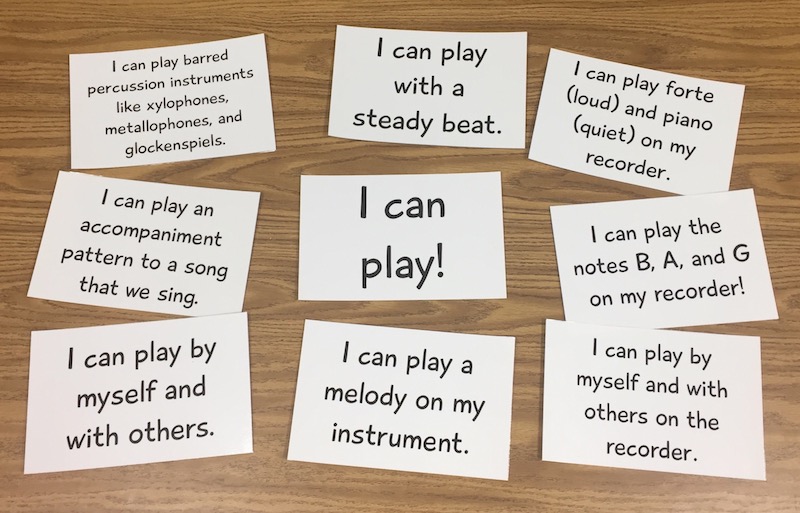
I Can Statements in the Music Room
In my very first teaching job I was told that I was expected to display “I CAN” statements for my students. They were to be displayed prominently in my classroom, referred to in each lesson, and should help explain to students the goals of the lesson and the take-away skills that they would learn. I wanted to comply with this directive from my principal but I didn’t really know what an “I CAN” statement would look like for my music classroom. We learn multiple things in each lesson… how was I supposed to limit that to one main objective? Or, if I was going to change my “I CAN” mid-lesson how do I do that without taking too much time and breaking up the flow of the lesson. I experienced a lot of frustration thinking about this my first few years and started to really hate having to display the statements! Why wasn’t it easier and why couldn’t the professional development actually give concrete examples of how this might look in a music classroom?
I thought I’d take a minute to share my ideas on how to display I Can Statements for students, administration, and parents. It is absolutely possible to use the “I CAN” concept without taking too much time away from class. What’s more, I’ve found throughout the years that there are a TON of different ways to display the required content in your classroom in a way that actually enhances student learning. Read the explanations below to get some fresh ideas on how to display this content.
What Are “I Can Statements” Anyway?
In a nutshell, I CAN statements are simple sentences designed by the teacher (or sometimes the school district) that are meant to direct classroom learning. The statements should be based off of local/state/national standards and should be directly tied to the curriculum being taught by each music teacher. The most important thing is that the “I CAN” statements should be written in student-friendly language. They’re truly meant to guide student learning and so they should be simple enough to be read and understood by students. Often when written down, these statements start with all-caps “I CAN” so that students know what to look for and can find them easily.
These statements should cover specific learning targets for each lesson and break down larger, more lofty objectives (sometimes called something like “power standards”) into simpler goals. For example, a large goal for a unit/lesson might be something like “The Learner will improvise a melody in a major key.” That’s a pretty intense goal and something I would never post for students to see. A goal like this is really something that takes time and might be the goal for the end of my unit/quarter. For each individual lesson you might turn the standard into statements like those below:
Basically, you have to break down your “power standard” into smaller parts. This is what we do every day anyway. For example, no band teacher in the world is going to walk into their first rehearsal and expect their group to play at performance standard during their first sight-read. Probably they’ll read through some of the music, pick one movement or part of the larger work, and then focus on learning/refining/crafting that section. You must first learn to walk before you can run, right? All you have to do for a good “I CAN” statement is break down your goal into smaller tasks and communicate those objectives in a student-friendly language.
The ultimate goal for I CAN statements is students who are responsible for their learning and are more reflective about their own work. The more the statements are used with kids, the more likely it will be that kids will really understand and take ownership of what they’re doing. The statements need to be used consistently in the learning process for them to be really effective. That means the teacher needs to actually craft statements that make sense to kids and refer to them before, during, and after the lesson for the content to really sink in. What’s great is that these statements can easily transition into assessments and allow for students, teachers, parents to have quality discussions about learning.
I like the idea of posting these “I Can” statements because they help to guide student learning and require me, the teacher, to really think through my lesson to make sure that my lesson goal matches the ultimate goal for the grade-level standard. These statements should support what we’re doing already… not take away time from planning or learning. The real question is, “How do I display this in my room in an effective way so that students in ANY grade level can find their objective, refer to it often, and understand what they’re doing.” That’s not such an easy question to answer.
Making the Standards Fun! – Bulletin Board Display
The first task when walking into the world of “I Can” statements is to get students, teachers, and parents to understand that you have goals and targets for learning. I’ve taught in buildings before where multiple people come up to me and say things like, “Wait, there are national standards for music?” or “Oh, you post I CAN statements too?” They seem initially to be baffled that I have learning goals or why I’m posting them for students to see. Immediately my guard goes up and I want to say something really heated about the national standards, all those hours I spent working on a curriculum team, or how I actually listen in faculty meetings where they talk about best practices. I have to choke back statements like “I didn’t get this master’s degree for nothing” or “we don’t just sing fun songs all day in class… we actually do learn things!” But then I take a second (and a very deep breath) and realize that the music teacher who came before me might not have been as vocal and open about the standards they followed/learning objectives. Or it could be that the teacher/parent who made the original statement might have had a music teacher in their elementary school as a kid that didn’t clearly explain the standards or goals of the lesson.
It is our goal as music teachers to educate others about and advocate for what we do. We need to communicate to students, parents, teachers, administrators about music education so they see the real value in what we do. Participating in music-making is a fun experience, absolutely. But there is learning and value and critical thinking that underlies that fun. I love this bulletin board set from my friend Sara Bibee (you’ve probably seen a lot of variations of this same idea on Pinterest). What a fun and visually pleasing way to show off how music is tied to history, language, science, and so much more. Two of the old national standards for music education were actually, “Understanding relationships between music, the other arts, and disciplines outside the arts.” and “Understanding music in relation to history and culture.” We need to continually point out these connection points and explain to parents how and why we make these connections with kids. In music class we do sing, dance, and play instruments but while we’re doing that we’re developing brains, introducing connections to other disciplines/cultures, and exploring the world around us and the imagined world.
So, with the idea that we should constantly be on the lookout for ways to advocate for music education, I’ve tried to make many of my public bulletin boards about the National Standards and our goals for learning. I dress up the standards with fun themes like Musical Pirates, Space Aliens, or Hot Air Balloons. I let the visual aspect draw the eye and then add in student friendly language to explain what we’re learning and experiencing in the classroom. Here are a few examples — just click to enlarge.
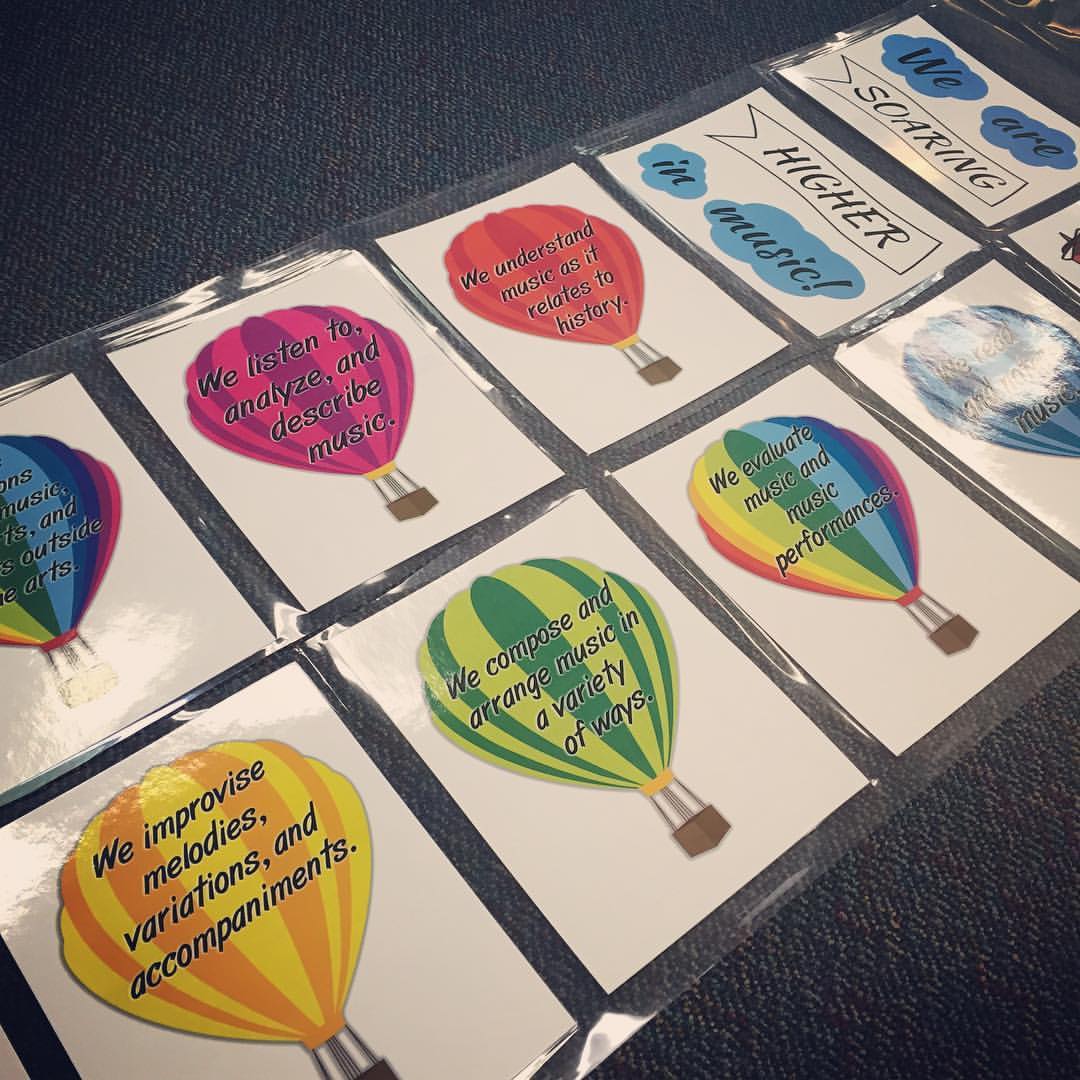
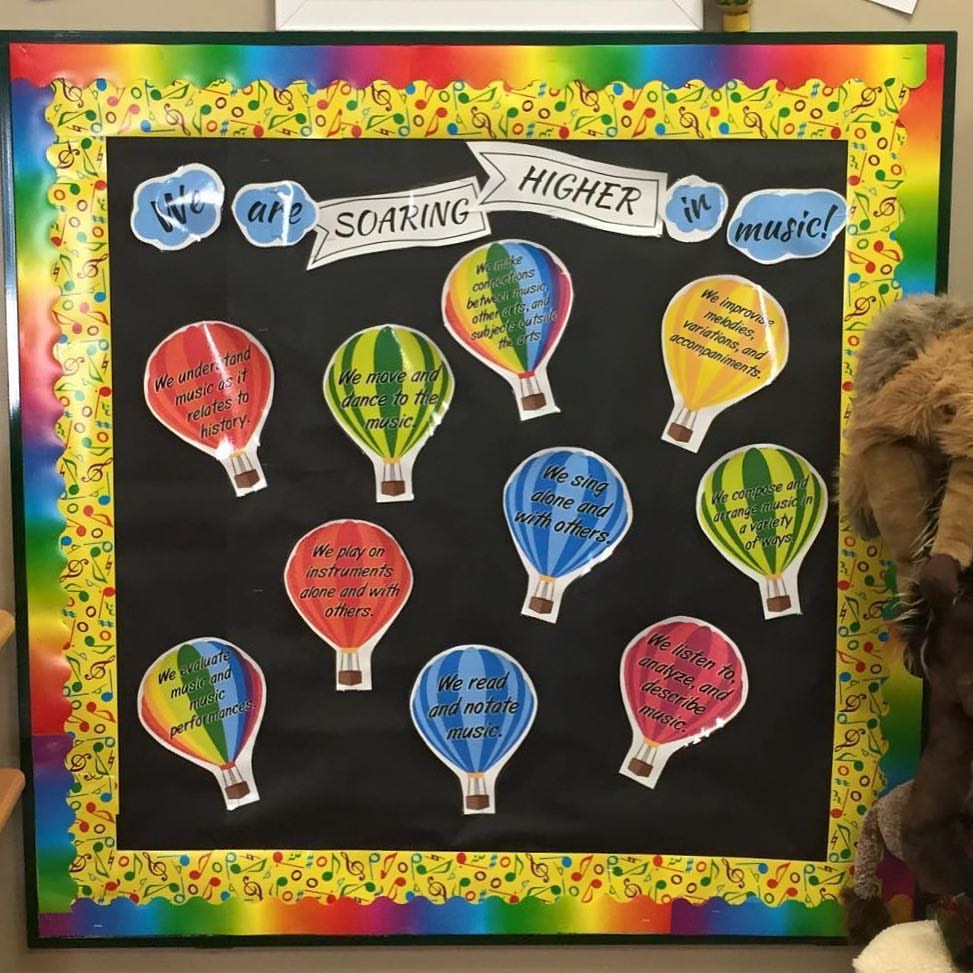
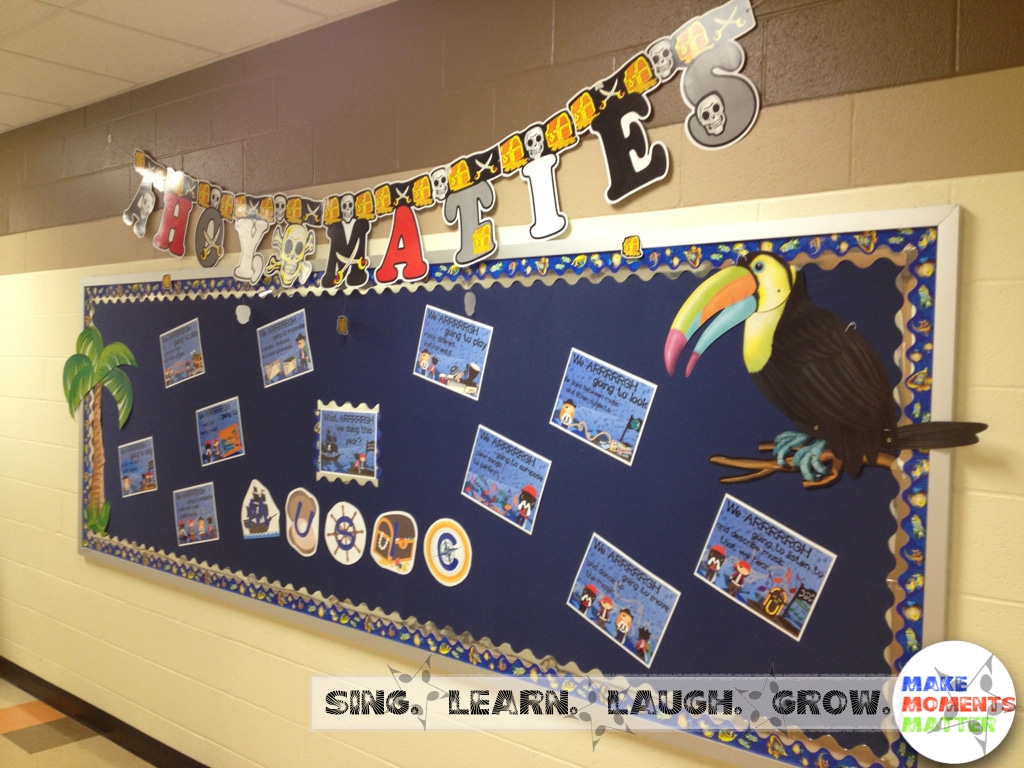
Displaying I Can Statements – Several Different Ways
There are a lot of different ways that you can display your standards and I CAN statements without causing too much difficulty or taking time away from instruction. Just do a quick search of Pinterest or spend any time on music educator forums on Facebook and you’ll see all kinds of different and creative ways to put your statements up for student to see. Just remember when you’re thinking about your own classroom that the goal of I CAN statements is that students will understand what they’re doing in each lesson and use that information to guide their behavior/learning. Think about putting the statements in a prominent place in your classroom like near the front door or next to your SMART board/white board. Put them somewhere kids can actually see them and refer to them as often as you can.
1) Posters for the Statements with Moving Grade Levels
My first crack at posting the I CAN statements came years ago when I created these posters for my very first classroom. I wanted to find a quick and easy way for students to see and understand the standards. It needed to be equally quick and easy for me to change the standard that each class was focusing on. So, I came up with these posters can I could post up on the wall and use over and over with multiple classes.
I simplified my I CAN statements to revolve around the National Standards for Music Education (1994). I put the overarching national standard in a small white box but also included a simplified version in slightly larger print below. The idea was that older students could refer to the larger and more complex standard (ex. I can sing by myself and with others) while younger students could look to the simplified version (I CAN sing). With this bulletin board set I included different numbers for each grade level. If a grade was focusing on one of the standards I would move their number to that poster. If I needed to change the I CAN in the middle of the lesson all I had to do was move their number to the new standard. Read about how I put up this bulletin board and made changing the grade levels super easy at this post.
Pros: It was super easy to change the standards as we went. All I had to do was to move a class’s number (the one corresponding to their grade) and we could switch the focus from playing to singing to improvising or anything else.
Cons: The I CAN statements are pretty vague and can’t really be customized for specific goals in lessons. The nine standards cover almost any activity I could come up with, but I still felt limited at times.
If you want to try out these posters for yourself, you can get them HERE for free!
2) Posters for Each Grade with Multiple Statements to Change
My second attempt at I CAN statements came with this bulletin board and its interchangeable standards. For a while I had been using a spot on the white board to hand write out my I CAN statements so that I could be more specific with each class. Remember, the true purpose of I CAN statements is to break the learning objectives down into smaller chunks that students can understand. My nine posters weren’t really achieving that goal. As I spent the countless hours writing out statement after statement I started to see a pattern. A lot of the same type of standard were popping up again and again. I began to write down some of the most commonly used statements and then branched out to come up with other “I CAN” language that would fit my lessons throughout the year.
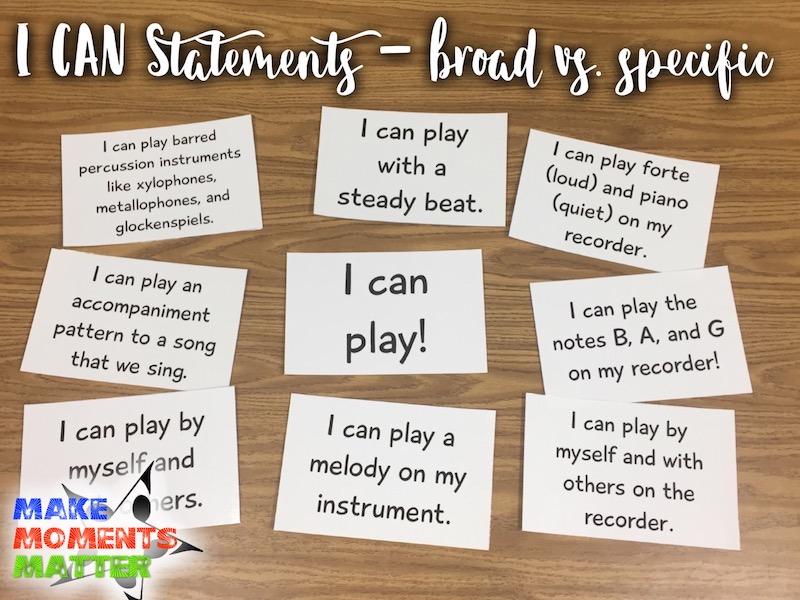
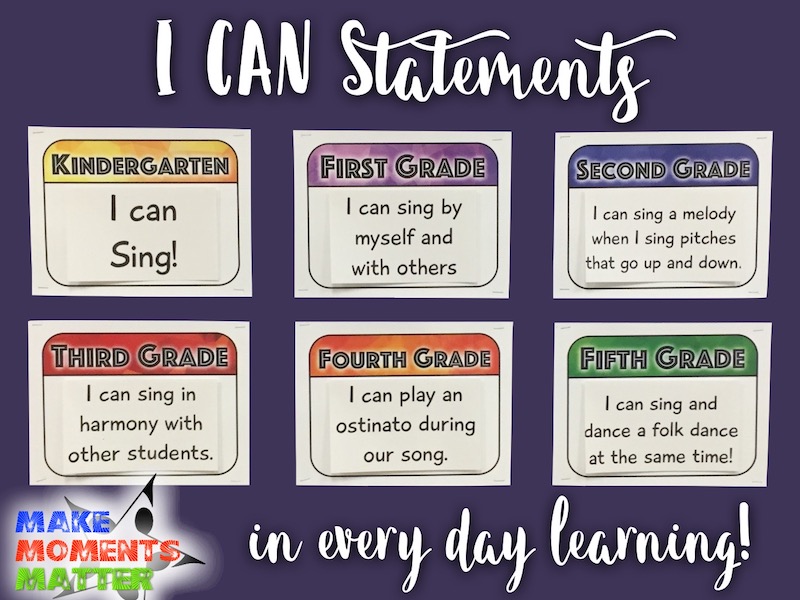
What I came up with was a set of blank posters for each grade level/subject area I was teaching (the backing page with headers like “Kindergarten” or “First Grade”). Then I printed out dozens of possible I CAN statements and put velcro dots on the back. Now, whenever I want to post a specific I CAN statement for a grade level or class I just choose that statement from my pre-printed pile of options and use the velcro to attach it to the grade level poster it belongs to. So, I have the specific I CAN statements that I got when I was hand-writing sentences on the white board but I don’t have to spend the time writing them up. Instead I just choose the statement I need and pop it up onto its velcro spot and voilà!
Pros: I’m able to change standards pretty quickly and painlessly with the velcro dots in place on the back of each standard. It’s also rather easy to customize our statement by grade level and standard. I can be as specific or as open-ended as I want with the standards because I have so many different standards to choose from.
Cons: The initial set-up takes a bit of printing/cutting/laminating. However, once everything is printed and done you can really go for it and use the standards you’re printed for multiple grades (some of the more broad statements like “I can sing alone and with others” could be used at any grade).
If you want to try out these posters for yourself, you can get them HERE!
3) Posted Statements or Notes to Send Home to Parents
A variation of the idea I posted just above this one is another process that I tried a few years ago. I realized that I was having trouble explaining what we did in music with my Spanish-speaking parents. I taught in a school where the English Language Learner (ELL) population was somewhere around 85% of the school, primarily using Spanish as their main language. I spoke enough Spanish and families spoke enough English that we could communicate about most behavior issues or opportunities for their students. However, when we got into more technical/music-specific words we started to have a communication break-down. I didn’t really know how to say things like “improvise” or “rhythm patterns” or “guided listening.”
So, I partnered with the translator in my district and came up with a variety of I CAN statements to translate into Spanish. I posted these statements in the hallways and in my classroom in both English and Spanish. Parents LOVE being able to read about what their students were doing and I saw a huge increase of parents obviously chatting with their students (in either language) about the activities and learning in the music room.
The real breakthrough came when I realized I could easily print the posters 4 to a page, one side English and one side Spanish, to send home with kids at the end of a unit. At regular intervals I would send home notes with all kids in the grade level that had a quick and easy statement like “I CAN sing by myself and with others.” I made sure that I included both English and Spanish so that all parents would understand. The response was overwhelmingly good. Parents felt involved and included and students definitely internalized the learning as they were now being asked at home about what they were doing in music class. See a detailed blog post all about this idea when you click HERE!
Pros: They’re great for parent communication and are easy to print/send home whether in color or black/white. They’re also pretty easy to display in my classroom. I staple a clear sheet protector to the bulletin board and slip these standards in and out as needed.
Cons: These are perfect as notes home with any grade level because it gives a great detailed description for parents. The downside is that they slant a little more towards primary grades because they’re more focused on drawing your eye with the chevrons and clip art. Not as versatile as option #2 above.
No matter what method you use, I CAN statements should function as a quick and easy way to refocus learning, guide instruction, and help students reflect on their work. I’ve seen people use pocket charts with pre-written sentence strips, whiteboards that are updated each week or unit, PowerPoint slides that are talked about before/after each lesson, and lots of other ideas. For me, it’s easy to stick up/take down pre-printed I CAN statements and with the large variety of statements that I put together, it’s not difficult to find an “I CAN” that matches what we’re doing in class. Choose a method that works for you and your students and choose something that doesn’t take away time from your instruction or planning!

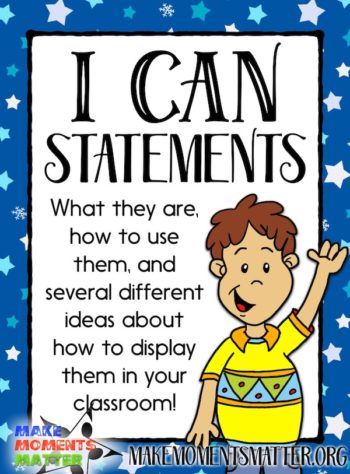
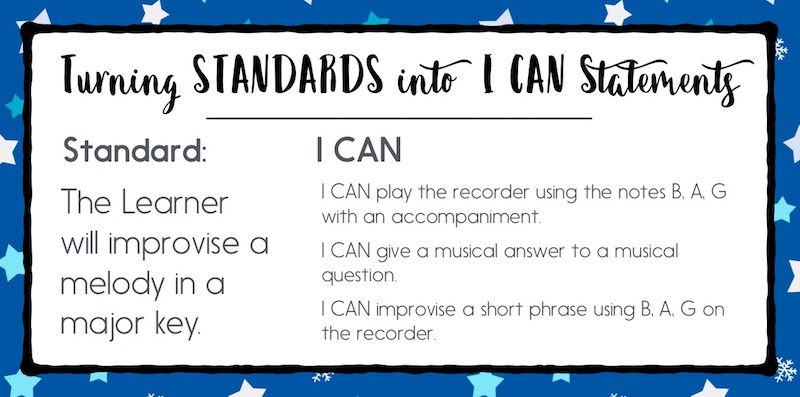
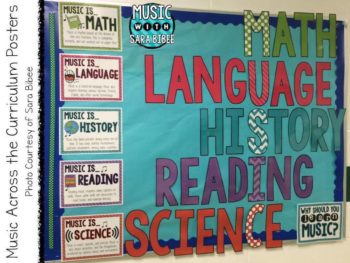
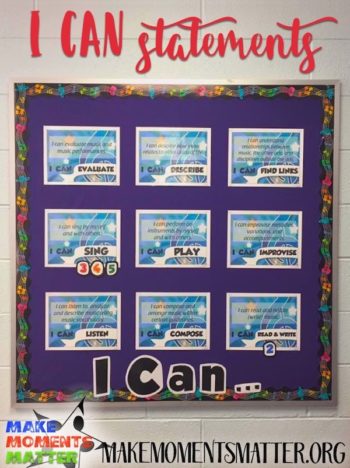
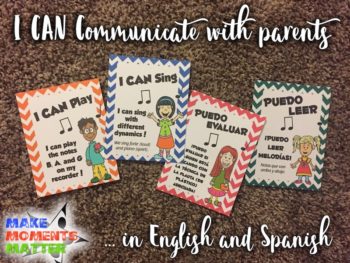
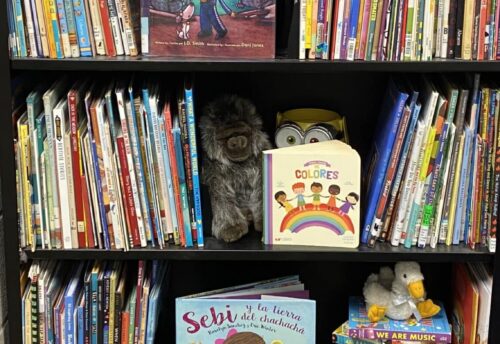
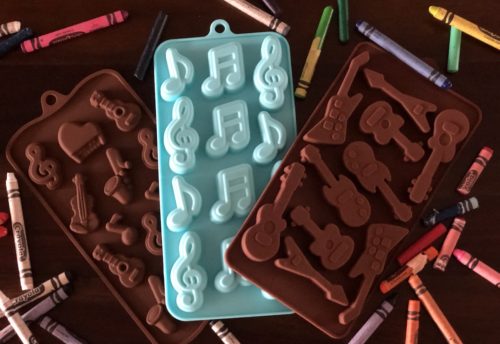
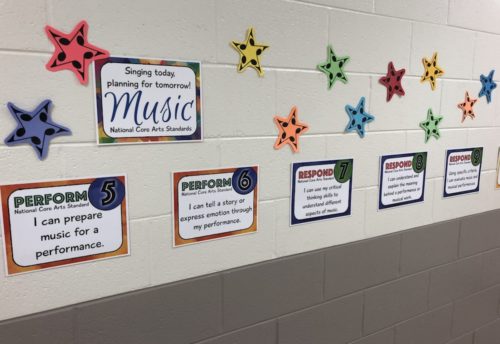
4 Comments